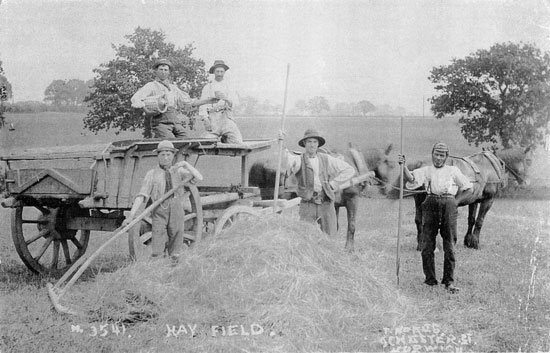Farm Work & Wages
Work & Wages at Paddock Farm, 1865-66
James Turner's farm account book for what is now known as Paddock Farm, Mulbarton, in 1865-6 gives a detailed diary of farm work when everything was done by hand. Accounts and notes are written in..........
'The Practical Farmers' yearly Account Book on a new and simple plan, shewing at one view an exact account of workmen's names, employment, wages and weekly settlement; together with a weekly account of cash received and paid for the various purposes of the farm, and a diary of occurrences, engagements, &c. .... Also Balance sheets of receipts and disbursements of the farm shewing the profit or loss at the year's end. By Samuel H Webb, late of Edgefield, Norfolk. 26th edition. London: Jarrold and Sons..... Norwich: Jarrold and Sons, London Street'
The Account Book also includes an Agricultural Calendar (and a drawing of Norwich Castle and cattle-market)
WORK & WORKERS
1 or 2 out of 14 men seem to work with the horses and are also involved with preparing fields for next year's crops:
'Plowing' continues from end of Oct to May. Drilling Barley
begins in March; drilling wheat begins in May; scarifying in May and June;
hoeing and hay-making in June and July, which includes cutting, carting, making
and trimming haystacks.

April 24th - 27th 1866 'stone-picking
company' = 39 people, mainly women and children (paid between 2 shillings and
1/4d, presumably depending on age:
Mrs Parfitt; M Dawson; Emily Kedge; Amelia Kedge; Harriett
Calver; Jane Emms; Maria Tyrell; James Beaumont; Harriett Skate; M A Mullen;
Matilda Stackyard; Anne Blyth; Malinda Huggins; Emma Dawson; Ann Banham; Hannah
Beaumont; William Emms; Robert Loveday; Ellen Dawson; James Williams; Thomas
Henry Blyth; Maria Townshend; Julia Beaumont; Samuel Bailey; Fanny Blyth;
Walter Calver; Rose Emms; Eliza Ba(nel? nch?); John Beaumont; Henry Stone; John
Kedge; Arthur Bishop; Alfred Banham; Charles Larter; Edward Blyth; Richard
Coan; Henry Townhend; Arthur Stone; Margaret Hayzell.
Most of these are also listed in June as part of a 'Weeding Company' = 28 people who receive between 3/8d and 7 shillings 2 weeks' work
HARVEST HOME
Wed 8th August 1866, Dawson and Banham are 'Cleaning the Harness' on the day before the Harvest begins.
The following account, with original spellings, has details added from information elsewhere in the book about field names, sizes and crops. 10 men and boys who cut, stacked and threshed the wheat and barley:
Thursday 9th August - Began Harvest today in Dry Close [8 ½ acres], the wages to be the same as other [years] per head, 6£.
Friday 10th - Began to cut Bush Pytle [4 acres]. Finished by 3 o'clock, went into Sarah Barleys, din about 2 ½.
Saturday 7th - Cutting Wheat in Sarah Barleys [12 acres].
Monday 13th - Began to cut Barley in Wheelwright Pytle [6 ½ acres]. Finish Sarah Barleys by 12 o'clock. Began to cut the Ten Acres [actually 9 ¾ acres].
Tuesday 14th Cutting Wheat in Ten Acres.
Wednesday 15th - Finished cutting Wheat in Ten Acres. Finished cutting Barley in Wheelwrights.
Thursday 16th - Thunder. Finish cutting Peters Close [6 ¾ acres]. Went into Six Acres and finished it [7 ½ acres].
Friday 17th - 10 till 3. Men began to work on bottom for stack in Ten Acres to put the Sarah Barleys about 10 acres of it on. [Using turnips, etc from the previous winter as a base for the sheaves.]
Saturday 18th - Finished the stack off first thing. Began another stack with the rest of Sarah Barleys. Began to thrash wheat from Ten Acres at 12 o-clock. Left off for dinner and finished at 5 o'clock and sent in to Cremers [the Miller] 55 comb. Top the stack up from Ten Acres, 1 load from Bush Pytle.
Monday 20th - Did not begin to Cart till 10 am. Began Bush Pytle unto stack in Ten Acres. Finished it from the Dry Close. The rest into barn - about 5 o'clock.
Tuesday 21st - Began to cut Swamp Barley [8 ½ acres]. Began to Cart Barley from Six Acres to stack in Ten Acres.
Wednesday 22nd - Damp. Cut the Catmer Hurn [5 ¼ acres]. Went on with Swamp.
Thursday 23rd - Dry. Finish cutting Swamp. Turned the Wheel[wrights] Pytle and part of Peters Close. Began to cart Wheelwrights Pytle. Finish it off.
Friday 24th - Dry. Trimming Wheat. Stack Turning. Barley in Peters Close begun. Jn Larter not well - left at 3 o'clock.
Saturday 25th - Turning in Swamp and [Catmere] Hurn. Cart Barley from Stack in the Field.
Then follows a list of wages: £6.10s to Mr. Dawson; £4 to C. Waller; £5.10s to Mr. Sleight; £6 each to John Larter; Mr. Kedge; H Larter; James Barrett; £2 each to W Banham and E Rice; £4. 14s to Cole; 15 shillings to W Kedge (boy); £1 to Mrs Kedge; 6 shillings each to Mrs Sleight; Mrs Kedge; and Mrs Larter; 5/3d to Mrs Dawson.
Monday 27th - Finished carting Swamp - 5 loads into the second stack and finished with Barley from the Catmer Hurn. Carted part of the Wheat rakings into barn. Thatching Barley stack in Ten Acres. Heaping Barley fom 8 o'clock until 5 o'clock all day.
Tuesday 28th - Finished getting the Wheat and Barley. Raking up Wheat into barn, Barley into Bullockshed. Thatching Barley stack in Swamp.
A double line in the account book shows the harvest is over. It was thirsty work: Mr Turner pays Mr Dye (of the Tradesman's Arms) just over 7 shillings for beer! But there is still plenty to do - mowing vetches in Burnt House Close; turning vetches; driving muck; barn jobs and thrashing. Mr Dawson has gone off to Norwich; the other regular workers are back to regular wages: between 4/6d and 6/- to the men; 1/6d to the boy.
